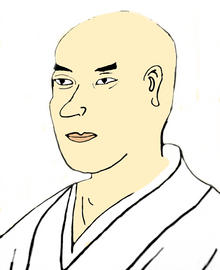Egaku | |||||||||
|---|---|---|---|---|---|---|---|---|---|
恵萼 | |||||||||
 Modern drawing of Egaku (early Heian period - early 9th century CE) | |||||||||
| Personal | |||||||||
| Born | unknown but before 822 [1][note 1] Japan | ||||||||
| Died | unknown but after 864 CE [3] Japan | ||||||||
| Religion | Buddhism | ||||||||
| Flourished | 9th Century CE | ||||||||
| School | Zen[2]: 7605 [note 2], Tendai | ||||||||
| Occupation | Buddhist monk, scholar | ||||||||
| Senior posting | |||||||||
| Teacher | Saichō, Yanguan Qi’an | ||||||||
| Chinese name | |||||||||
| Traditional Chinese | 慧鍔 | ||||||||
| Simplified Chinese | 慧锷 | ||||||||
| |||||||||
| Vietnamese name | |||||||||
| Vietnamese | Huệ Ngạc or Tuệ Ngạc | ||||||||
| Korean name | |||||||||
| Hangul | 혜악 | ||||||||
| Hanja | 慧鍔 | ||||||||
| |||||||||
| Japanese name | |||||||||
| Hiragana | えがく | ||||||||
| Part of a series on |
| Buddhism in Japan |
|---|
 |
Egaku or Hui'E [note 4] was a well-connected 9th century Japanese scholar-monk [5]: 46 [note 5] who made frequent trips to Tang China for pilgrimage and bringing back Buddhist teachings to Japan. Egaku had a huge impact on the religious and cultural history of China and Japan.[6]: 1 [note 6] In Japan, he is famous for bringing the first Rinzai Zen monk Gikū[2]: 7605 [note 7] and the works of the Chinese poet Bai Juyi to Japan.[5]: 47–49 In China, he is renowned for his role in establishing a developed pilgrimage site in Putuoshan, one of the four major Buddhist pilgrimage sites in China.[7]: 14 [note 8] [4][note 9]
- ^ a b Putuoshan 2017 慧锷,又译惠萼、慧谔、慧萼[、惠蕚],是入唐求法的学问僧和请益僧,又是日本天台宗始祖最澄大师高足。Hui'E, also known as 慧锷,惠萼、慧谔、慧萼[、惠蕚] was the disciple of the founder of the Japanese Tendai Sect Saichō.
- ^ a b Foguangshan 1989
- ^ Chen 2010, p. 47 最后于咸通五年(日本贞观六年 ,864)和入唐僧贤真 、忠全等一起从明州回到日本。从此以后 ,其名便消失在这一时代的史籍之外了 。Egaku returned to Japan for the last time in 864 CE from Ningbo; with two Japanese monks who had earlier accompanied him on the way to China, Genma and Zenchū. After that, Egaku's name disappears from the historical record.
- ^ a b Putuoshan 2017
- ^ a b Chen 2010
- ^ Tanaka 2011
- ^ Wang 2009
Cite error: There are <ref group=note> tags on this page, but the references will not show without a {{reflist|group=note}} template (see the help page).